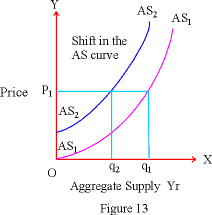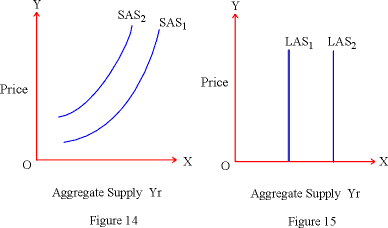|
(C) The two phases: The two phases need some explanation.
Initially, at the low levels of output produced and supplied, a
very small proportion of available resources is utilized. So long
as labor, plants and equipment, land etc. are underutilized or unemployed,
marginal cost of employing them is relatively low. Therefore more
and more output can be produced and supplied with reasonably small
rises in the price level. But as resource utilization tends to a
fuller level, the marginal cost of employing resources starts rising
sharply. Ultimately, when all available resources are exhausted,
the condition of no further supply of real goods and services
is reached (that is the full employment level). If the price level
beyond this point continues to move upward it can no more induce
additional production and supply. Rising price level will then be
purely inflationary without adding any more to the output
level.

Aggregate supply curve may shift upwards (leftward) or downwards (rightward). In figure 13 O-AS1 is the original supply curve and AS2 - AS2 is the new upwards or leftwards shifted Aggregate Supply curve. On the new supply curve at a given price P1 aggregate supply has decreased from q1 to q2. If we were to start initially from O-AS1 curve then O-AS would have been a rightward or a downward shifted supply curve showing greater quantity supplied at a given price level. Such shifts in the supply curve are caused by a variety of dynamic changes taking place in the economy. Technological improvements, skill development of labor, innovation, foreign trade prospects are some of examples of it. These factors may cause either favorable or unfavorable effects on the supply conditions. Their unfavorable nature causes an upward shift and favorable effects lead to a downward shift. In the long run, a downward shift in the aggregate supply conditions is normally experienced when an economy has been making progress and development.
(D) Short and Long run supply: Earlier we
have seen that aggregate supply curve has two phases. Initially
on the flatter portion more and more output can be produced with
a small rise in the price level. This is possible so long as some
resources are unemployed or underemployed. But once the economy
reaches a point close to full employment of resources, the supply
curve becomes very steep and vertical. These two phases can be associated
with short and long run transitions in the aggregate supply
conditions as well. The flatter initial phase is a short-term phenomenon
whereas steeper vertical portion is experienced in the long run.
The distinction is based on the fact that progressive fuller utilization
of available resources is a time-consuming activity. Besides there
is another contributory factor which causes lapse of time between
the two phases. Several resource agents or factors of production
are employed on the basis of contracted remuneration. Rate of wages,
rent of land and building premises, interest on the loan funds are
all examples of contract payments. These contracts last for six
months, a year or for a longer period. With an initial rise in the
price level contracted factor payments do not rise and quick expansion
in the output becomes possible at fairly steady costs. This explains
the short run, flatter portion of the supply curve. But after the
lapse of time when the contractual period is over the factor agents
demand higher remuneration to compensate for the inflationary price
rise. This suddenly causes cost of production to rise sharply. The
long run supply curve therefore tends to get steeper and gradually
attain a vertical shape. But note that both the causes namely fuller
utilization of resources and renewal of contracts at higher factor
prices together cause steepness and rigidity in the long run supply
conditions.

Figure 14 shows relatively flatter short run supply curves while figure 15 shows long run supply curves. Corresponding to the two earlier phases we have here drawn two separate supply curves.
|
Index
4.1 Aggregate Demand
4.2 Aggregate Supply
4.3 Equilibrium
Chapter 5 |